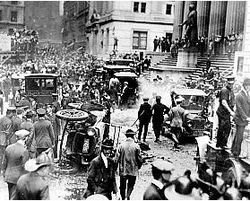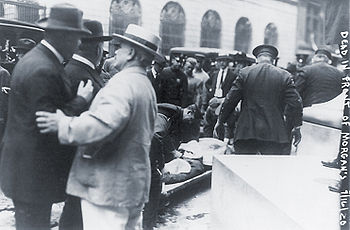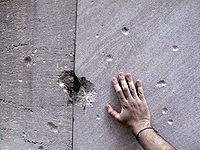- Wall Street bombing
-
Wall Street Bombing 
The aftermath of the explosion.
Federal Hall is at the right.Location New York City, New York Date September 16, 1920
12:01 p.m. (local time)Target Wall Street Attack type bomb concealed in horse-drawn wagon Death(s) 38 Injured 400 Perpetrator(s) Galleanist anarchists are suspected The Wall Street bombing occurred at 12:01 p.m. on September 16, 1920, in the Financial District of New York City. The blast killed 38 and seriously injured 143.[1] Although the bombing was never solved, investigators and historians think it likely the Wall Street bombing was carried out by Galleanists (Italian anarchists), a group responsible for a series of bombings the previous year. The attack was related to postwar social unrest, labor struggles and anti-capitalist agitation in the United States.
The Wall Street bomb caused more fatalities than the bombing of the Los Angeles Times building in 1910, and was the deadliest act of terrorism on U.S. soil up to that point.[2]
Contents
Attack
At noon, a horse-drawn wagon passed by lunchtime crowds on Wall Street in New York City and stopped across the street from the headquarters of the J.P. Morgan bank at 23 Wall Street, on the Financial District's busiest corner. Inside, 100 pounds (45 kg) of dynamite with 500 pounds (230 kg) of heavy, cast-iron sash weights exploded in a timer-set detonation,[3] sending the slugs tearing through the air.[4] The horse and wagon were blasted into small fragments, but the driver was believed to have left the vehicle and escaped.
The 38 victims, most of whom died within moments of the blast, were mostly young people who worked as messengers, stenographers, clerks and brokers. Many of the wounded suffered severe injuries.[5] The bomb caused more than $2 million in property damage ($23 million inflation adjusted) and destroyed most of the interior spaces of the Morgan building.[6]
Reaction
The Justice Department's Bureau of Investigation (BOI) did not immediately conclude that the bomb was an act of terrorism. Investigators were puzzled by the number of innocent people killed and the lack of a specific target, other than buildings that suffered relatively superficial, non-structural damage. Exploring the possibility of an accident, police contacted businesses that sold and transported explosives.[7] By 3:30 p.m., the board of governors of the New York Stock Exchange had met and decided to open for business the next day. Crews cleaned up the area overnight to allow for normal business operations the next day, but in doing so they destroyed physical evidence that might have helped police investigators solve the crime.[1] The New York assistant district attorney noted that the timing, location, and method of delivery all pointed to Wall Street and J.P. Morgan as the targets of the bomb, suggesting in turn that it was planted by radical opponents of capitalism such as Bolsheviks, anarchists, communists, or militant socialists.[8] Investigators soon focused on radical groups opposed to U.S. financial and governmental institutions and known to use bombs as a means of violent reprisal. They observed that the Wall Street bomb was packed with heavy sash weights designed to act as shrapnel, then detonated on the street in order to increase casualties among financial workers and institutions during the busy lunch hour. Officials eventually blamed anarchists and communists. The Washington Post called the bombing an "act of war."[9] The Sons of the American Revolution had previously scheduled a patriotic rally for the day after (September 17) to celebrate Constitution Day at the exact same intersection. On September 17, thousands of people attended the Constitution Day rally in defiance of the previous day's attack.[10]
The bombing stimulated renewed efforts by police and federal investigators to track the activities and movements of foreign radicals. Public demands to track down the perpetrators led to an expanded role for the U.S. Justice Department's Bureau of Investigation (BOI) (the forerunner of the Federal Bureau of Investigation), including the General Intelligence Division of the BOI headed by J. Edgar Hoover.[11]
On September 17, the BOI released the contents of flyers found in a post office box in the Wall Street area just before the explosion. Printed in red ink on white paper, they said: "Remember, we will not tolerate any longer. Free the political prisoners, or it will be sure death for all of you." At the bottom was: "American Anarchist Fighters."[12] The BOI quickly decided that the flyer eliminated the possibility of an accidental explosion. William J. Flynn, Director of the BOI, suggested the flyers were similar to those found at the June 1919 anarchist bombings.[12][13]
 The September 16th Wall Street bomb killed 38 people, the city's worst disaster since the 1911 Triangle Shirtwaist Factory fire.
The September 16th Wall Street bomb killed 38 people, the city's worst disaster since the 1911 Triangle Shirtwaist Factory fire.
Investigations
The investigation conducted by the Bureau of Investigation stalled when none of the victims turned out to be the driver of the wagon. Though the horse was newly shod, investigators could not locate the stable responsible for the work.[12] When the blacksmith was located in October, he could offer the police little information.[14]
The Bureau of Investigation and local police investigated the case for over three years without success. Occasional arrests garnered headlines but each time they failed to support indictments.[15] Most of the investigation initally focused on anarchists and communists, including the Galleanist group, who authorities believed were involved in the the 1919 bombings.[16] During President Warren G. Harding's administration, officials evaluated the Soviets as possible masterminds of the Wall Street bombing[17] and then the Communist Party USA.[18] In 1944, the Federal Bureau of Investigation, successor to the BOI, investigated again. It concluded that its agents had explored many radical groups, "such as the Union of Russian Workers, the I.W.W., Communist, etc....and from the result of the investigations to date it would appear that none of the aforementioned organizations had any hand in the matter and that the explosion was the work of either Italian anarchists or Italian terrorists."[19]
One Galleanist in particular, Mario Buda (1884–1963), an associate of Sacco and Vanzetti, and the owner of a car which led to the arrest of the latter for a separate robbery and murder, is alleged by some historians, including Paul Avrich, to be the man most likely to have planted the bomb.[20] Avrich and other historians theorize that Buda acted in revenge for the arrest and indictment of his fellow Galleanists, Sacco and Vanzetti.[20][21][22] Buda's involvement as the Wall Street bombmaker was confirmed by statements made by his nephew Frank Maffi and fellow anarchist Charles Poggi, who interviewed Buda in Savignano, Italy, in 1955.[23] Buda (at that time known by the alias of Mike Boda) had eluded authorities at the time of the arrests of Sacco and Vanzetti, was experienced in the use of dynamite and other explosives, was known to use sash weights as shrapnel in his time bombs, and is believed to have constructed several of the largest package bombs for the Galleanists.[24][25][20] These included a large black powder bomb that killed nine policemen in Milwaukee, Wisconsin in 1917.[26][27][28][4][24] Buda was in New York City at the time of the bombing, but he was neither arrested nor questioned by police.
After leaving New York, Buda resumed the use of his real name in order to secure a passport from the Italian vice-consul, then promptly sailed for Naples.[4] By November he was back in his native Italy, never to return to the United States.[4] Other Galleanists still in the U.S. continued the bombing and assassination campaign for another twelve years, culminating in a 1932 bomb attack targeting Webster Thayer, the presiding judge in the Sacco and Vanzetti trial.[20] Thayer, who survived the ensuing blast that destroyed his house and injured his wife and housekeeper, moved his residence to his club for the remainder of his life, where he was guarded 24 hours a day.[20]
Later mentions
Jed Rubenfeld's mystery-thriller The Death Instinct uses the bombing as a key plot element.[29]
See also
- Domestic terrorism in the United States
- Animal borne bomb attacks
Notes
- ^ a b Gage, Beverly, The Day Wall Street Exploded: A Story of America in its First Age of Terror. New York: Oxford University Press (2009), pp. 160-161.
- ^ It was surpassed in fatalities by the Bath School bombings in Michigan seven years later.
- ^ Watson, Bruce, Sacco and Vanzetti: The Men, the Murders, and the Judgment of Mankind, New York: Viking Press (2007), p. 77
- ^ a b c d Avrich, Paul, Anarchist Voices: An Oral History of Anarchism in America, Princeton, NJ: Princeton University Press, (1996), pp. 132-133
- ^ Gage, p. 329-30.
- ^ New York Times: "Havoc Wrought in Morgan Offices," September 17, 1920, accessed February 4, 2010
- ^ New York Times: "Explosives Stores All Accounted For," September 17, 1920, accessed February 4, 2010
- ^ Gage, pp. 150-151
- ^ History News Service: Beverly Gage, "The First Wall Street Bomb", accessed September 16, 2010
- ^ Gage, 166-8
- ^ Gage, Beverly, The Day Wall Street Exploded: A Story of America in its First Age of Terror, New York: Oxford University Press (2009), pp. 272-282
- ^ a b c Gage, pp. 171-175
- ^ Funds are Needed in Fight on Reds, The New York Times, 19 September 1920, accessed February 4, 2010
- ^ Gage, p. 225-6
- ^ Gage, pp. 217-219, 249-253
- ^ Gage, pp. 207-208
- ^ Gage, pp. 261-90
- ^ Gage, pp. 295-308
- ^ Gage, p. 325
- ^ a b c d e Avrich, Paul, Sacco and Vanzetti: The Anarchist Background, ISBN 0691026041, 9780691026046 (1991), pp. 213, 227
- ^ Avrich, Paul, Anarchist Voices: Interview of Charles Poggi, p. 133: Among other interesting admissions, Buda acknowledged that Niccola Sacco was in fact present ("Sacco c'era") at the South Braintree payroll robbery and murder for which he was eventually executed.
- ^ Newby, Richard, Kill Now, Talk Forever: Debating Sacco and Vanzetti, AuthorHouse, ISBN 9780759607927 (2011), p. 590
- ^ Avrich, Paul, Anarchist Voices: Interview of Charles Poggi, p. 133: "Buda was a real militant, capable of anything. In 1933 I drove to New York with Buda's nephew, Frank Maffi...Frank said, 'Let's drive downtown and see my uncle's bomb', and he took me to Wall Street, where the big explosion took place in September 1920, just before Buda sailed for Italy. You could still see the holes in the Morgan building across the street."
- ^ a b Dell’Arti, Giorgio, La Storia di Mario Buda, Io Donna, 26 gennaio 2002, http://www.memoteca.it/upload/dl/E-Book/Mario_Buda.pdf
- ^ Watson, Bruce, Sacco and Vanzetti: The Men, the Murders, and the Judgment of Mankind, Viking Press (2007), ISBN 0670063533, 9780670063536, p. 15
- ^ Milwaukee Police Department Officer Memorial Page from the City of Milwaukee website
- ^ Watson, Bruce, Sacco and Vanzetti: The Men, the Murders, and the Judgment of Mankind, Viking Press (2007), ISBN 0670063533, 9780670063536, p. 15
- ^ Balousek, Marv, and Kirsh, J. Allen, 50 Wisconsin Crimes of the Century, Badger Books Inc. (1997) ISBN 1878569473, 9781878569479, p. 113: The 1917 bomb used black powder with a homemade sulfuric acid/metal plate "time" fuse, which failed to explode until the package was opened at the police station. By 1920, it is notable that Galleanist bombmaker(s) had apparently discontinued the use of the unreliable acid detonators in favor of dynamite with an electric blasting cap and a clock wired to a battery as a timed detonator.
- ^ Washington Post: Seth Stern, "Book review: 'The Death Instinct' by Jed Rubenfeld," February 23, 2011, accessed May 19, 2011
Categories:- 1920 crimes
- 1920 disasters
- 1920 in New York
- 20th-century explosions
- Explosions in the United States
- Disasters in New York City
- Crime in New York City
- Terrorist incidents in the United States
- Terrorist incidents in New York
- Terrorist incidents in the 1920s
- Wall Street
- Improvised explosive device bombings
- Political violence in the United States
- History of New York City
- History of anarchism
- History of the United States (1918–1945)
- Murder in New York
- Unsolved murders in the United States
- Car and truck bombings in the United States
Wikimedia Foundation. 2010.

